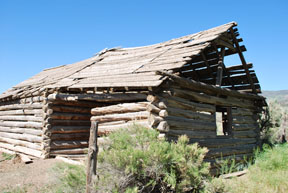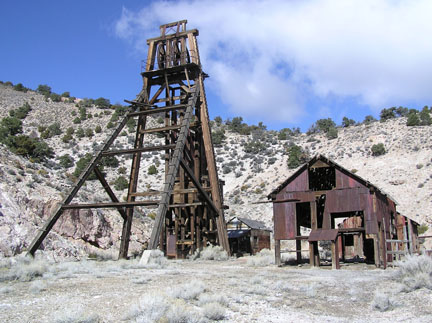Frisco, Utah – population zero – is in Beaver County outside of Milford. It may be dead now, but at one point it had a reputation as the “Wildest Town in the West.” According to Stuart Burgess, a mining and ghost town aficionado, it was described in its day as, “Dodge City, Tombstone and Sodom and Gomorrah all rolled into one.”

In 1875, Jim Ryan and Sam Hawkes discovered an outcropping of silver. Legend says they discovered it when their mule kicked a rock. They picked it up to find it was almost pure silver. They staked a claim which they later sold and the Horn Silver Mine was born. By 1910 it had produced 20 million tons of high grade ore. The town of Frisco grew up around the mine.
The town started to die when the mine collapsed in 1885. The mine foreman felt a shuddering and refused to let anyone into the mine. When it collapsed there were no injuries or fatalities. That is, except for Frisco. The mine lingered on for a while, but as the ore gave out people moved away.
Today visitors can still see the Frisco Cemetery and huge oven-like structures that were the charcoal kilns. Mining equipment, rusted and broken, and weathered buildings are all that remain of the once wild town.
Stuart Burgess became “addicted to mining history” as he put it, at an early age. He started an organization called Mohave Underground. The group brings together people interested in exploring, preserving and documenting abandoned mines in the American West. Finding a way to turn his passion into a living, he explores abandoned mines for mining companies or landowners. He rappels into mines that others can’t navigate to do surveys, take samples and photos and document if there is enough ore left in a mine to reopen for operations.
Burgess explains there are many factors which turned once vibrant communities into abandoned relics. Falling mineral prices shut down mines. Railroads and highways bypassed some towns, cutting them off from the rest of civilization. Resources dried up or disasters struck. In some cases, the younger generation simply moved away.
A town in Spring Canyon called Standardville was described as the prettiest coal town in Carbon County.

It had a population of 2,000 and boasted tennis courts, a swimming pool, an elementary school and houses made of brick and stone. The coal mine that the town was built around opened in 1895. The mine suffered setbacks with a 1922 strike and a 1930 methane gas explosion, but continued to operate until 1960 when the coal finally ran out. According to Burgess, “When the mine died the town died too.”
The history of many but not all ghost towns is connected to mining operations. Grafton in Southern Utah was settled in 1859 for cotton farming. The town was beset with flooding problems, and in 1866 it was evacuated during the Black Hawk War. Most of the residents didn’t return. In 1944, the last remaining resident left Grafton behind.
Over 200 abandoned towns populate Utah’s geography silently waiting to be rediscovered and explored. An atlas is a good tool to start an adventure. If a town is listed on the map and underneath the town there appears the word “site,” this designates it is a ghost or abandoned town. There are also several guidebooks offering directions, histories and landmarks.
The towns will never truly die if they are remembered. So, get out and do some exploring and take some advice from Burgess, “Be safe, have fun and take lots of pictures! Many of these incredible monuments of our history are disappearing very quickly. Enjoy them while they are still around.”
Burgess loves to share his knowledge and experience. This summer he is offering presentations at several Salt Lake County libraries. §





